The Lowdown
There is no question that the Runhood power system can get pricey. At the same time, by taking a modular approach, the company not only lets each consumer create the system that best meets their own needs, but it also allows for a degree of flexibility and expansion that is unique in the marketplace.
Overall
Pros
- Refined design is more attractive than the competition’s industrial look
- Top handle makes it easy to carry
- Plenty of connectivity options for all your devices
- Hot-swappable batteries let you customize the power of the system
- When individual batteries are paired with one of the available “engines” they become usable on their own
- Bundled price saves significant money
Cons
- The modular system is great but adds to the complexity of using the Runhood
- Includes a bag for cables but not for other accessories like spare engines
We have recently seen a proliferation of high-capacity batteries for hunting and camping and as a replacement for gas or propane generators when the power goes out. None, however, have the innovative design of the Runhood Modular Power Station system; its design lets you create the system that’s right for you and then add to it as your needs grow.

This past summer, we endured our power company taking up residency behind my house for over a week as they trimmed back or cut down countless trees in the glen behind my house.
While I was not too fond of the noise and miss the trees they took down, I understand why they felt the need to do so. Our power lines also run behind my house, and those trees inevitably cause power outages during winter storms.
The power company hoped that clearing the power lines of potential tree limbs would eliminate the constant power losses, and they were right! We have yet to lose power this winter. (But I still miss my trees.)
At the same time, history means I have taken steps to be better prepared for the next time the power goes out. This included purchasing a propane generator, which has proven to be loud and quickly burns through propane tanks. But after using it during two power outages twice last winter, it has seemed like a reasonable tradeoff.
Large-capacity portable battery banks are also a great solution. They usually won’t run a full-size refrigerator, but they will keep most basic house electronics going for a significant amount of time.
Add in the fact that many come with cables, so you can recharge them using your car’s power port or an optional solar panel, and you can keep the power banks charged for as long as you need them. We have reviewed several such portable power solutions, but none have the industrial design or flexibility of the Runhood Modular Power Station.
Most of the large power stations in this category are large, boxy batteries with a utilitarian design. Inside are battery arrays and, on the top or front, a series of inputs and controls so you can recharge the battery and connect various devices that need power.
By contrast, the Runhood system takes a modular approach and, as a result, is far more flexible and customizable than anything we have previously seen.
Let’s dig into the system a bit.
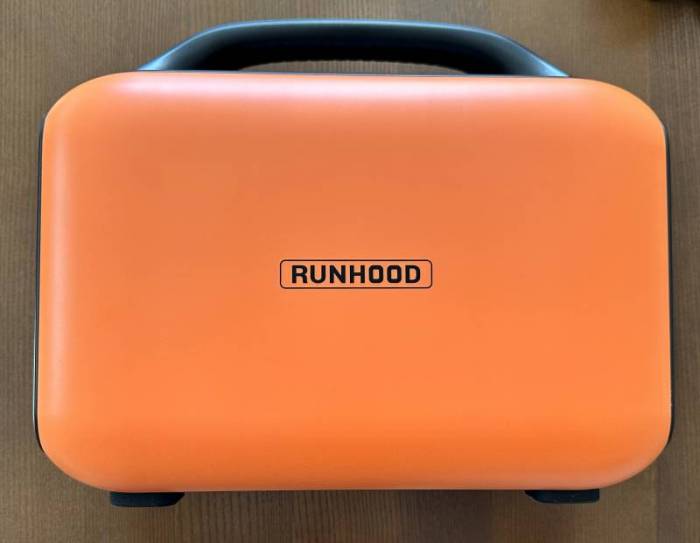
At the heart of the Runhood system is the Runhood 600W Host Engine, which on its own, retails for $349.
The 600W Host Engine includes the housing and controller, a number of cables, and a quick guide. Unlike similar products with a boxy, utilitarian design, the Runhood 600W Host Engine has gentle curves, a bright orange body, and a rounded handle.
All of these features combine to create a battery housing that is a bit more consumer-friendly from an aesthetic perspective.

The front face of the 600W has an LCD interface that provides a great deal of information, two US 110 outlets with “pure sine wave 110 V 60Hz,” a USB-C PD 100 bi-directional ports, a USB-C PD 100 output port, two USB-A 3.0 ports that deliver 28W, a bi-directional carport and two DC 60W ports.
- Cable for the 12V Automotive power port
- Cable for an optional solar panel
- The 12V Auto power port
A 24V DC in port is available for charging via your home outlet, a car power port, or the Runhood solar panel.
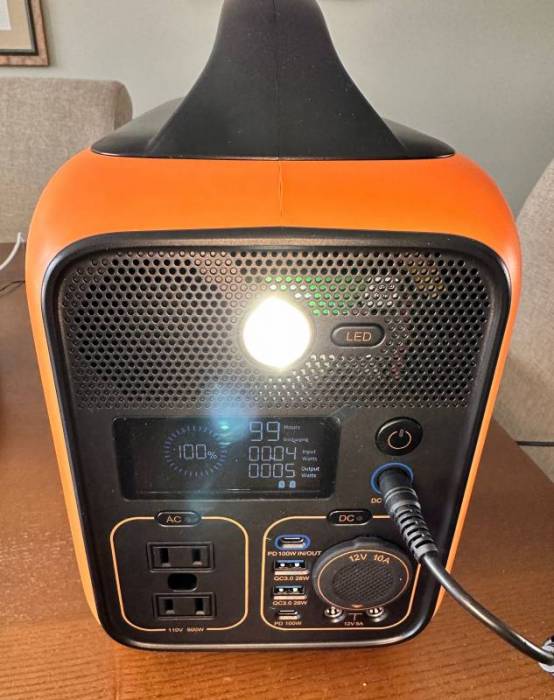
Finally, a built-in light is controlled via the LED button next to it.

The Runhood 600W Host Engine interface offers all the ports and connectivity options you’ll need, encased in a refined package.

But the Host Engine is just one piece of this modular system, and it doesn’t have any batteries inside; that’s where the EB324 Energy Bars come in.

As noted, the front of the Runhood 600W Host Engine has all the controls and connectivity options. The back has two buttons and two rectangular caps. Pressing either button releases the rubber cap just beneath it and reveals a rectangular slot that runs from the back to the front of the 600W controller.
Each slot can accept one Energy Bar 324 for 648W output power when both are charged and inserted; each battery measures 10.2″ by 2.3″ by 4.1″, weighs under 4 pounds, and is rated to maintain 80% capacity after 1000 charges.
A package of two EB324 batteries, AKA a Rallye Juice Pack, retails for $440; you can also purchase the batteries individually at $249, but the cost-savings when you buy two makes that a poor option.
The batteries can be recharged when plugged into the Runhood 600W Host Engine; they can also be recharged from solar with the optional $49.99 cables.
Why would you want to charge one of the EB324 batteries on its own? We’ll get to that soon.
Combining the Runhood 600W Host Engine with two EB324s creates what the company calls a Rallye 600. While you could buy each component separately (at a retail cost of ~$850), purchasing the Rallye 600 configuration will set you back $739 when it’s not on sale.
The Rallye 600 setup can power a laptop for 10 hours, a light for 65 hours, a mini cooler for 10 hours, a TV for 10 hours, and a mini fridge for 9 hours. No, it won’t power a full-size refrigerator; for that, you still need something more powerful.
So, in short, if you have the Runhood 600W Host Engine and two of their EB324 batteries, you have a 648Wh battery system for your next outing or power failure. But that begs the question of why this approach is advantageous compared to battery systems that lack a similarly flexible design.
The answer is twofold.

First, the Runhood batteries are hot-swappable. That means you can purchase additional EB324 batteries, keep them charged, and then swap out a spent battery for a fresh one when necessary.
Once the spent energy bar has been removed, you can recharge it using your car battery or the solar panel and have it ready to swap back in when the time comes.
That’s also the first reason it is important to charge each battery on its own.

The second reason is that each EB324 battery can be used as a power source when you purchase either the $95 Runhood 256W DC Engine or the $80 Runhood 110V/80W Engine. They each connect to the end of an EB324 battery and lock in place until two buttons, one on either side, are simultaneously depressed.
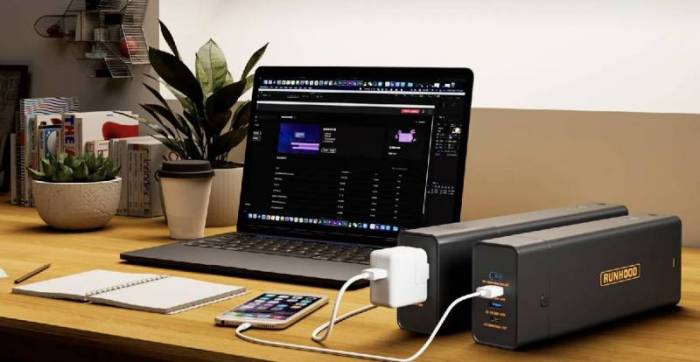
The Runhood 110V/80W lets you plug one device with a US110 plug-in while the Runhood 256W DC Engine provides a bi-directional USB-C PD 100W, a USB-C PD 100W output, and two USB-A QC3.0 28W outputs.
The beauty of this approach is that it means you can take significant power without the need to carry the entire Runhood system with you; that kind of flexibility makes this system special.
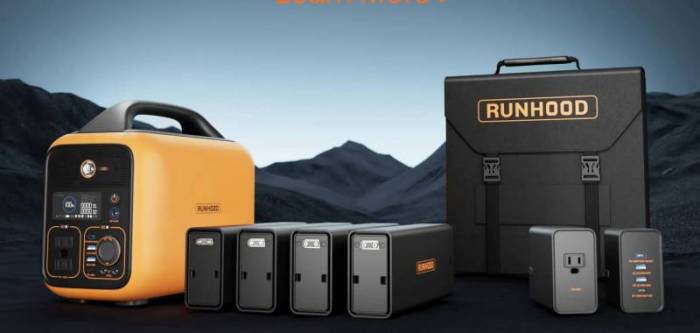
The Rallye 600 PRO bundle
Finally, you can purchase a Runhood Seri 100W solar panel for $299. The panels are waterproof and foldable and can be used either as a single panel or as a pair for added power.
Each panel offers a maximum output of 100W and makes it possible to keep the Runhood EB324 batteries charged, even when you are off the grid. I wasn’t sent a solar panel with the review system to test, but I’ll likely purchase one in the future and will update this review with their performance then.

It is good to know that various options for recharging your Runhood system exist.
When the Runhood 600W is loaded with two EB324 batteries, it presents as a fairly standard power station. However, thanks to the company’s modular approach, you can purchase additional batteries and hot-swap them with the ones in the Runhood 600W Host Engine, so you have zero downtime.
In addition, each EB324 battery can function as a standalone battery when you need to travel light. Best of all, you can start with a simple system and then, if your needs grow, expand the system without needing to purchase an entirely new power station.

The Rallye 600 PLUS bundle
Even so, if you are considering the Runhood system, it makes sense to look at one of the bundles they currently offer.
The Runhood Rallye 600 includes the 600W housing plus two batteries for $739, while the Rallye 600 Plus includes all that and two additional batteries (a total of four) for $1219.
The Rallye 600 Max builds on the Plus model by adding the AC and the DC Engines, so you can use each battery on its own, while the $1659 Rallye 600 PRO includes everything in the Max setup plus one solar panel.
Each of these bundles is currently on sale. Check the company website to check out the current sale prices.

There is no question that the Runhood power system can get pricey. At the same time, by taking a modular approach, the company not only lets each consumer create the system that best meets their own needs, but it also allows for a degree of flexibility and expansion that is unique in the marketplace.
As soon as the review sample came, I charged it up, but thankfully, we haven’t needed it yet. And while I hope that continues, I know that if we lose power, we’ll have the Runhood modular power station to help keep the lights on.
Runhood Modular Power Station prices start at $739 for the Ralley 600 model; they are available directly from the manufacturer and other retailers, including Amazon.
Source: Manufacturer supplied review sample
What I Like: Refined design is more attractive than the competition’s industrial look; Top handle makes it easy to carry; Plenty of connectivity options for all your devices; Hot-swappable batteries let you customize the power of the system; When individual batteries are paired with one of the available “engines” they become usable on their own; Bundled price saves significant money
What Needs Improvement: The modular system is great but adds to the complexity of using the Runhood; Includes a bag for cables but not for other accessories like spare engines






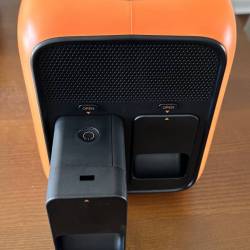
Thanks for the rundown. I may have to invest!
like the options
This is a remarkably flexible system.
It’s good to know there is the ability to add to the system as your future needs grow. I like that it has a number of different options to recharge including the use of a solar panel.
Still hoping to invest in one of these. I’ve enjoyed the several competitor reviews you’ve also posted.